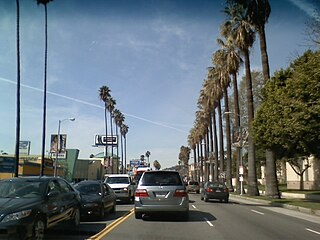
Sunset Boulevard is a boulevard in the central and western part of Los Angeles, California, United States, that stretches from the Pacific Coast Highway in Pacific Palisades east to Figueroa Street in Downtown Los Angeles. It is a major thoroughfare in the cities of Beverly Hills and West Hollywood, as well as several districts in Los Angeles.
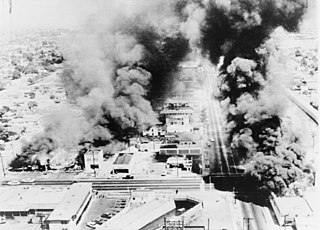
The Watts riots, sometimes referred to as the Watts Rebellion or Watts Uprising, took place in the Watts neighborhood and its surrounding areas of Los Angeles from August 11 to 16, 1965.
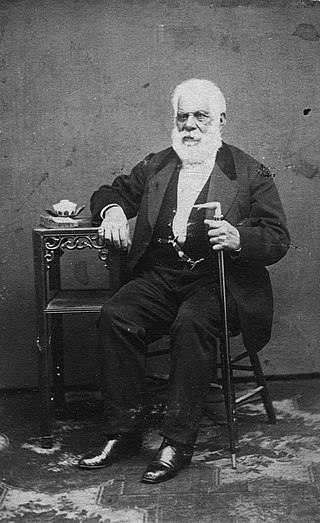
Don Pío de Jesús Pico was a Californio politician, ranchero, and entrepreneur, famous for serving as the last governor of Alta California under Mexican rule. A member of the prominent Pico family of California, he was one of the wealthiest men in California at the time and a hugely influential figure in Californian society, continuing as a citizen of the nascent U.S. state of California. His legacy can be seen in the numerous places named after him, such as the city of Pico Rivera, Pico Boulevard in Los Angeles, Pio Pico State Historic Park, and numerous schools that bear his name.

Watts is a neighborhood in southern Los Angeles, California. It is located within the South Los Angeles region, bordering the cities of Lynwood, Huntington Park and South Gate to the east and southeast, respectively, and the unincorporated community of Willowbrook to the south.

Chinatown is a neighborhood in Downtown Los Angeles, California, that became a commercial center for Chinese and other Asian businesses in Central Los Angeles in 1938. The area includes restaurants, shops, and art galleries, but also has a residential neighborhood with a low-income, aging population of about 7,800 residents.

Highland Park is a neighborhood in Los Angeles, California, located in the city's Northeast region. It was one of the first subdivisions of Los Angeles and is inhabited by a variety of ethnic and socioeconomic groups.

Olvera Street, commonly known by its Spanish name Calle Olvera, is a historic pedestrian street in El Pueblo de Los Ángeles, the historic center of Los Angeles. The street is located off of the Plaza de Los Ángeles, the oldest plaza in California, which served as the center of the city life through the Spanish and Mexican eras into the early American era, following the Conquest of California.
The Broadway was a mid-level department store chain headquartered in Los Angeles, California. Founded in 1896 by English-born Arthur Letts Sr., and named after what was once the city's main shopping street, the Broadway became a dominant retailer in Southern California and the Southwest. Its fortunes eventually declined, and Federated Department Stores bought the chain in 1995. In 1996, Broadway stores were either closed or converted into Macy's and Bloomingdales.
Thomas Jefferson Cuddy, known as T.J. Cuddy, nicknamed Tom, was a 19th-century police chief in Los Angeles, California, until bribery forced resignation, and member of the Los Angeles Common Council, the city's governing body. He served a six-month jail term for contempt of court.
Los Angeles Street, originally known as Calle de los Negros is a major thoroughfare in Downtown Los Angeles, California, dating back to the origins of the city as the Pueblo de Los Ángeles.
Aliso Village was a housing project in Los Angeles, California. It was built in 1942 and demolished 1999. The 29-acre (120,000 m2) parcel was replaced by Pueblo del Sol.

El Pueblo de Los Ángeles Historical Monument, also known as Los Angeles Plaza Historic District and formerly known as El Pueblo de Los Ángeles State Historic Park, is a historic district taking in the oldest section of Los Angeles, known for many years as El Pueblo de Nuestra Señora la Reina de los Ángeles del Río de Porciúncula. The district, centered on the old plaza, was the city's center under Spanish (1781–1821), Mexican (1821–1847), and United States rule through most of the 19th century. The 44-acre park area was designated a state historic monument in 1953 and listed on the National Register of Historic Places in 1972.
Main Street is a major north–south thoroughfare in Los Angeles, California. It serves as the east–west postal divider for the city and the county as well.
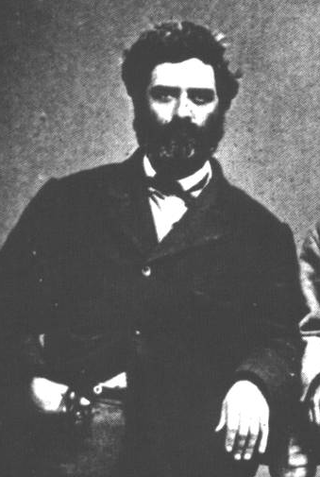
Tomas Avila Sanchez (1826–1882), soldier, sheriff and public official, was on the Los Angeles County, California, Board of Supervisors and was a member of the Los Angeles Common Council, the legislative branch of the city.
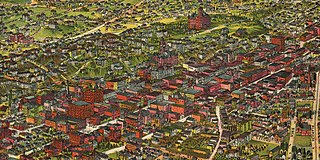
The late-Victorian-era Downtown of Los Angeles in 1880 was centered at the southern end of the Los Angeles Plaza area, and over the next two decades, it extended south and west along Main Street, Spring Street, and Broadway towards Third Street. Most of the 19th-century buildings no longer exist, surviving only in the Plaza area or south of Second Street. The rest were demolished to make way for the Civic Center district with City Hall, numerous courthouses, and other municipal, county, state and federal buildings, and Times Mirror Square. This article covers that area, between the Plaza, 3rd St., Los Angeles St., and Broadway, during the period 1880 through the period of demolition (1920s–1950s).
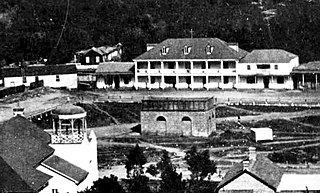
The Lugo Adobe also called the Vicente Lugo Adobe or Casa de Don Vicente Lugo was a house in the city of Los Angeles, located on the east side of the Los Angeles Plaza at 512–524 N. Los Angeles Street.

Yaanga was a large Tongva village, originally located near what is now downtown Los Angeles, just west of the Los Angeles River and beneath U.S. Route 101. People from the village were recorded as Yabit in missionary records although were known as Yaangavit, Yavitam, or Yavitem among the people. It is unclear what the exact population of Yaanga was prior to colonization, although it was recorded as the largest and most influential village in the region.
The history of Los Angeles began in 1781 when 44 settlers from central New Spain established a permanent settlement in what is now Downtown Los Angeles, as instructed by Spanish Governor of Las Californias, Felipe de Neve, and authorized by Viceroy Antonio María de Bucareli. After sovereignty changed from Mexico to the United States in 1849, great changes came from the completion of the Santa Fe railroad line from Chicago to Los Angeles in 1885. "Overlanders" flooded in, mostly white Protestants from the Lower Midwest and South.
Louise M. Harvey Clarke (1859–1934) was a medical doctor and widely known writer, speaker, and clubwoman in Los Angeles and Riverside counties, California.

Casa de Castelar was an American settlement in Los Angeles, California. It was founded in February 1894, during the settlement movement era, by a local branch of the College Settlements Association called the Los Angeles Settlement Association (LASA). Casa de Castelar was the first settlement house in the city, and the first settlement house west of the Mississippi River.





















